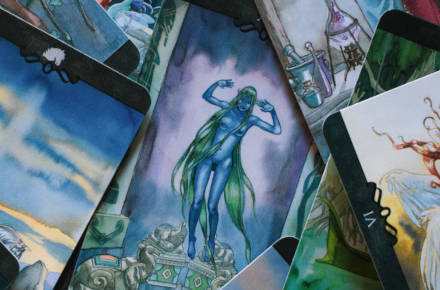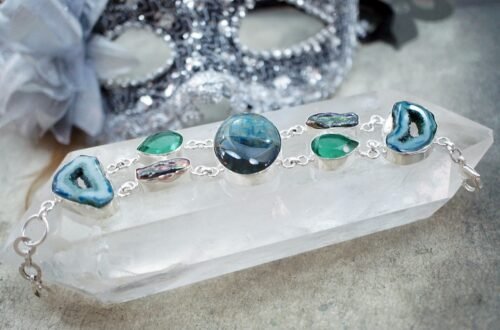
Tarot card Moon – meaning
In the realm of divination and spiritual exploration, few tools hold as much allure and intrigue as the Tarot. Among the 78 cards in a standard Tarot deck, each one carries a unique symbolic language that can offer profound insights into various aspects of life. The Moon card, numbered XVIII, stands as a captivating archetype that unveils the enigmatic realm of the subconscious mind and the mysteries that lie beyond the veil of consciousness.
The symbolism of the Moon Card
When the Moon card appears during a Tarot reading, it typically depicts a serene and mystical scene. A crescent moon is often showcased against a dark night sky, accompanied by stars, a path, and two large towers on either side. Below the moon, we see a body of water, representing the vast expanse of emotions and intuition. In the foreground, a dog and a wolf are seen, symbolizing the taming of wild instincts and primal forces. The symbolism within the Moon card points towards a journey of self-discovery, where the seeker must navigate through the dark and mysterious landscapes of their subconscious mind. The moon’s crescent shape suggests cycles, hidden aspects, and the waxing and waning of emotions and experiences. The twin towers represent the gateways to deeper understanding and higher consciousness, as well as the duality inherent in life. The path between the towers is a reminder of the way forward, guided by intuition and subconscious insights.
The Moon Card meaning:
At its core, the Moon card invites the seeker to embrace the realm of the unconscious mind, inviting them to explore their deepest fears, desires, and dreams. Unlike the clarity offered by the Sun card, which represents conscious awareness and illumination, the Moon card points to a more obscure, mysterious, and intuitive realm. It encourages the individual to trust their instincts, listen to their inner voice, and be open to the subtle signs and symbols that may otherwise go unnoticed.
- Intuition and emotions: The Moon card highlights the power of intuition and the vast sea of emotions that can sway decisions and actions. It urges the seeker to pay attention to their feelings and inner guidance, even when logic and reason seem to suggest otherwise. Intuition serves as a beacon in times of uncertainty and can lead to deeper understanding and personal growth.
- Navigating the subconscious: Just as the moon’s light illuminates the night, the Moon card calls for illumination within the darkness of the subconscious mind. The seeker is prompted to explore their hidden fears, anxieties, and unresolved emotions, providing an opportunity to confront and integrate these aspects into their conscious awareness.
- Deception and illusion: The Moon card serves as a reminder that not everything is as it appears. Illusions, self-deception, and hidden truths may cloud judgment and perception. The card encourages the seeker to discern between reality and imagination, to avoid falling victim to illusions or being misled by others.
- Facing shadows: Like the presence of the wolf and dog in the card, the Moon prompts the seeker to come to terms with their primal instincts and “shadow self.” This darker aspect, which often hides in the depths of the subconscious, represents the repressed and less desirable aspects of the individual. Confronting these shadow elements can lead to self-awareness and personal transformation.
- Creativity and imagination: The Moon card also celebrates the power of creativity and the vast realms of imagination. It encourages the seeker to tap into their creative potential and explore their dreams and fantasies as a means of self-expression and personal growth.
Reversed Moon Card
When the Moon card appears in a reversed position during a Tarot reading, its meaning may take on a slightly different tone. Reversed, the Moon card might indicate confusion, emotional instability, or an unwillingness to confront hidden truths. The seeker may be grappling with unresolved fears or refusing to embrace their intuitive guidance. Furthermore, the reversed Moon card could suggest a period of uncertainty and insecurity, making it essential for the individual to trust their instincts and seek clarity amidst the confusion.
In Conclusion
The Moon card in the Tarot offers a profound and captivating journey into the depths of the subconscious mind. It urges seekers to embrace their intuition, explore their emotions, and confront the shadows that lie within. The card is a reminder of the ever-changing nature of life and the cyclical patterns that govern human experiences. As with any Tarot card, the Moon’s interpretation should be considered in the context of the entire reading and the individual’s unique circumstances. By delving into the mysteries of the Moon, one can uncover hidden truths, embark on a transformative inner journey, and find guidance in the darkest of times. Embracing the Moon’s wisdom allows the seeker to walk the path of self-discovery, leading to profound spiritual growth and a deeper connection with their innermost self.




